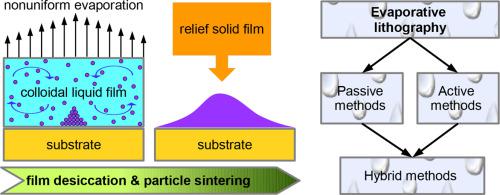Advances in Colloid and Interface Science ( IF 15.6 ) Pub Date : 2020-09-17 , DOI: 10.1016/j.cis.2020.102271 K.S. Kolegov , L.Yu. Barash

|
This review covers experimental results of evaporative lithography and analyzes existing mathematical models of this method. Evaporating droplets and films are used in different fields, such as cooling of heated surfaces of electronic devices, diagnostics in health care, creation of transparent conductive coatings on flexible substrates, and surface patterning. A method called evaporative lithography emerged after the connection between the coffee ring effect taking place in drying colloidal droplets and naturally occurring inhomogeneous vapor flux densities from liquid–vapor interfaces was established. Essential control of the colloidal particle deposit patterns is achieved in this method by producing ambient conditions that induce a nonuniform evaporation profile from the colloidal liquid surface. Evaporative lithography is part of a wider field known as “evaporative-induced self-assembly” (EISA). EISA involves methods based on contact line processes, methods employing particle interaction effects, and evaporative lithography. As a rule, evaporative lithography is a flexible and single-stage process with such advantages as simplicity, low price, and the possibility of application to almost any substrate without pretreatment. Since there is no mechanical impact on the template in evaporative lithography, the template integrity is preserved in the process. The method is also useful for creating materials with localized functions, such as slipperiness and self-healing. For these reasons, evaporative lithography attracts increasing attention and has a number of noticeable achievements at present. We also analyze limitations of the approach and ways of its further development.
中文翻译:

在蒸发光刻中应用液滴和薄膜
这篇综述涵盖了蒸发光刻的实验结果,并分析了该方法的现有数学模型。蒸发的液滴和薄膜用于不同的领域,例如冷却电子设备的加热表面,医疗保健中的诊断,在柔性基板上创建透明导电涂层以及表面图案化。建立了一种在干燥胶体液滴中发生的咖啡环效应与从液-气界面自然产生的不均匀蒸汽通量密度之间的联系之后,出现了一种称为蒸发光刻的方法。在该方法中,通过产生引起从胶体液体表面产生不均匀的蒸发轮廓的环境条件,来实现对胶体颗粒沉积图案的基本控制。蒸发光刻是称为“蒸发诱导自组装”(EISA)的更广泛领域的一部分。EISA涉及基于接触线工艺的方法,采用粒子相互作用效应的方法以及蒸发光刻技术。通常,蒸发光刻是一种灵活的单步工艺,具有以下优点:简单,价格低廉,并且无需进行预处理即可应用于几乎任何衬底。由于在蒸发光刻中对模板没有机械影响,因此在该过程中保留了模板完整性。该方法对于创建具有局部功能的材料(如滑爽性和自愈性)也很有用。由于这些原因,蒸发光刻技术引起了越来越多的关注,并且目前有许多明显的成就。



























 京公网安备 11010802027423号
京公网安备 11010802027423号